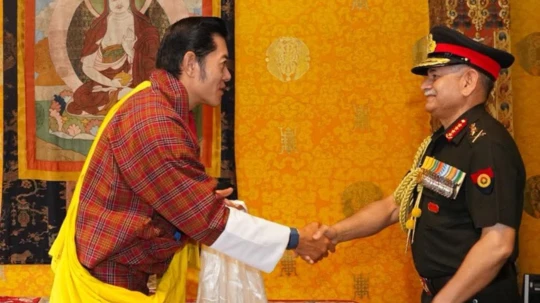India’s defence posture in the Himalayas received a decisive boost this week as Chief of Army Staff General Upendra Dwivedi concluded a high-stakes visit to Bhutan, aimed squarely at reinforcing the fragile Himalayan security architecture against China’s creeping territorial advances.
The four-day visit from 30 June to 3 July 2025 saw renewed military cooperation and joint readiness discussions.
Nestled between China’s Tibet Autonomous Region and India’s northeastern states, Bhutan plays an outsized role in South Asia’s strategic calculus. Its 605-km border with India and the vulnerable 477-km frontier with China place it right in the eye of Beijing’s expansionist storm. Nowhere is this more critical than near the Doklam tri-junction, where the 2017 standoff exposed China’s playbook: stealthy infrastructure build-ups, dual-use settlements, and grey-zone tactics designed to change facts on the ground without firing a shot.
Defending the Siliguri Corridor: India’s Chicken’s Neck Under Threat
The Siliguri Corridor, India’s vulnerable “chicken’s neck”, remains the Achilles’ heel of Indian defence. Any Chinese gains in Doklam could potentially sever India’s northeast from the mainland. Since 2016, Beijing has reportedly completed at least 22 settlements inside or near Bhutan, with eight perilously close to Doklam. Roads, communications towers, and bunkers point to dual-use capabilities.
Bhutan’s refusal to join China’s Belt and Road Initiative (BRI) and its repeated requests for Indian reinforcement highlight Thimphu’s alignment with New Delhi in resisting Beijing’s advances.
China’s Dual-Use Villages: Settlements Might Mask Military Intent
A 2020 New York Times report revealed satellite imagery, expossing China’s growing footprint inside Bhutanese territory. From the notorious Pangda village, which was built nearly 2 km within Bhutan’s borders in 2020, to new roads, military outposts, and bunkers, Beijing’s so-called “civilian villages” are anything but benign. As per experts like Maj Gen Sanjay Soi (Retd), these outposts allow the PLA to monitor India’s thin, 24-km-wide Siliguri Corridor.
India sees this as a textbook case of salami-slicing: an inch today, a mile tomorrow. By avoiding outright conflict and instead shifting borders subtly, China is working to undermine India’s strategic depth without provoking full-scale war.
India Slams China’s Meddling in Dalai Lama Succession
Adding to the Himalayan tensions, India firmly rebuffed China’s claims over selecting the next Dalai Lama. Parliamentary Affairs and Minorities Minister Kiren Rijiju minced no words, declaring that the Tibetan spiritual leader’s succession is a religious matter, not a geopolitical one. “The right to decide on his successor rests solely with him, in accordance with centuries-old Buddhist customs,” Rijiju asserted.
China has long sought to install a compliant figurehead within Tibet, but the 90-year-old Dalai Lama, who has lived in exile in India since 1959, has made clear his successor will be chosen by the Gaden Phodrang Trust and likely emerge from outside Chinese-controlled Tibet, which is another point of contention between Beijing and New Delhi.
Indo-Bhutan Military Ties Get a Fresh Boost
Meanwhile, General Dwivedi’s meetings with Bhutanese King Jigme Khesar Namgyel Wangchuck, former King Jigme Singye Wangchuck, and Royal Bhutan Army Chief Lt-Gen Batoo Tshering centred on one issue: coordinated deterrence. Their discussions addressed joint border surveillance, response mechanisms to PLA movements, and military capacity-building.
In a symbolic gesture, General Dwivedi visited the Indian Military Training Team (IMTRAT)-India’s oldest overseas mission. IMTRAT plays a crucial role in mentoring Bhutanese troops and fostering operational synergy. He praised Indian and Bhutanese soldiers for their “focused joint training and leadership development,” acknowledging IMTRAT’s pivotal role in cementing defence cooperation. Visits to key installations such as Project DANTAK, Gyalsung Academy, and the Wangchuk Lo Dzong Military Hospital further underscored India’s all-encompassing approach from hard security to humanitarian support.
